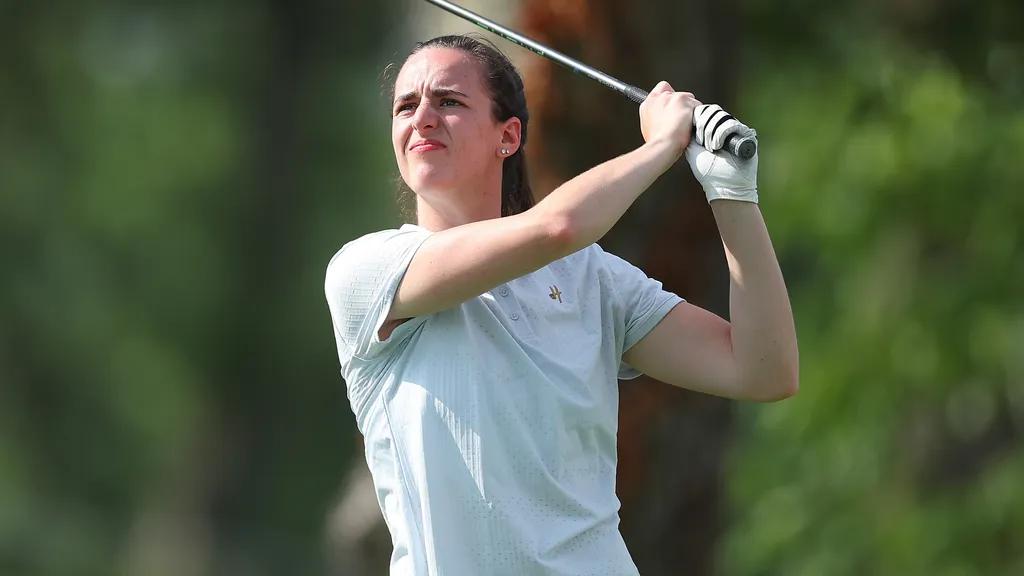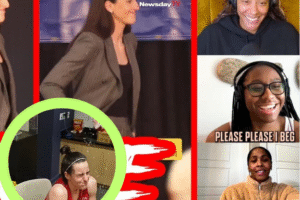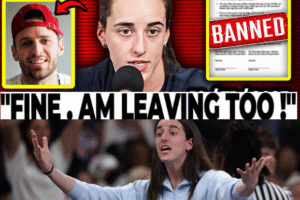It began as a quiet, late-season Pro-Am, an event so far down the sports calendar it wasn’t even scheduled to be televised. The RSM Classic was supposed to be a relaxed outing, a chance for pros and a few celebrities to mingle. Then, a single name was added to the player list: Caitlin Clark.
In an instant, everything changed. The event went from calm to chaos. Tickets that had been sitting for weeks vanished in hours. At sunrise, the gates were mobbed not by the usual golf patrons in polos, but by a sea of fans wearing Indiana Fever jerseys. The demand was so overwhelming, so immediate, that frantic organizers and broadcast partners scrambled to put the event on live television.
This was the “Caitlin Clark Effect” in its purest form, a traveling phenomenon that had just found a new sport to conquer. And by the time the day was over, she wouldn’t just conquer it—she would leave its biggest legend speechless and, in the process, expose a bitter divide in her own league.

The first sign that this would be no ordinary celebrity showing came on the first tee. As Clark, smiling and calm, walked up to her ball, a hush fell over the thousands who had gathered. She took a breath, swung her driver, and the sound of “pure contact” echoed across the fairway. The ball exploded off the club face, a perfect missile that landed 270 yards away.
The crowd erupted. But the most telling reaction came from the man who has seen everything in this sport: Tiger Woods. He was seen laughing, almost in disbelief, and said under his breath, “That’s the best first swing I’ve ever seen from a non-pro.”
It was a premonition. This wasn’t a basketball player on vacation. This was a transcendent athlete applying her singular focus to a new craft. Before the day was halfway over, Steph Curry, a formidable amateur golfer himself, tweeted, “Caitlin Clark might just be better than me at this point.” The internet broke. ESPN was calling her “the most natural crossover athlete since Michael Jordan.”
But the real shock was yet to come. This was not a day of lucky shots. This was a systematic dismantling of a golf course by someone who “just wanted to relax and have fun.” On the par-4 seventh hole, her approach shot took off, landed perfectly on the green, and rolled to a stop just inches from the cup. The crowd gasped, then roared.
When the final putt dropped, the scoreboard told a story that seemed impossible: 13 under par. A previous Pro-Am record, shattered. Tiger Woods, no longer just impressed, was reportedly left “speechless,” simply clapping in admiration. He later told reporters it was “one of the cleanest, most confident swings I’ve ever seen from someone outside professional golf.”
This is where the story splits in two. As the golf world rolled out the red carpet, a very different, and very cold, reception was emanating from the world she dominates.
The golf community, from its legends to its current stars, embraced her with universal acclaim. LPGA pros showed “full respect.” Nelly Korda, the world’s #1, told Clark, “You belong here.” Maria Fassi chased her down to thank her for “kicking ass on and off the field.” The LPGA itself, which had smartly paired her with its top player, was praised for “doing everything right.” They understood what the WNBA, bafflingly, has not: you don’t silence the “Clark Effect,” you celebrate it.

Tiger Woods, the sport’s gatekeeper, didn’t just offer praise. He reportedly offered her a private training session, an almost unheard-of invitation into golf’s inner circle. He didn’t see a threat; he saw, as LeBron James would later post, someone who is “different.”
Then, there was the WNBA. As Clark was rewriting records and dominating headlines in a sport she barely plays, the video’s narrator points to a “deafening silence” from her most prominent rivals. “The same people who accused her of getting too much attention suddenly lost their Wi-Fi,” one analyst noted. Fans immediately flooded the social media accounts of players like A’ja Wilson and Angel Reese, asking one simple question: “Why?”
The contrast was brutal. The golf world saw her talent and said, “Welcome.” The WNBA, or at least a vocal faction, sees that same talent and, as the narrative suggests, sees a threat. The LPGA’s broadcast drew higher ratings than most of its finals, all because of Clark. They were celebrating, while her home league was “awkwardly silent.”
Clark, for her part, handled the alleged snub with her typical, effortless class. When asked about the silence, she just smiled. “I’m focused on what makes me happy,” she said. “That’s competing, no matter what sport it is.”
That competition translated into an immediate financial earthquake. The 1,200% ticket spike was just the start. In the 48 hours that followed, Clark reportedly signed three new, massive endorsement deals—with a golf apparel company, a high-end watch brand, and a beverage company—totaling a reported $15 million. She made more in one weekend of golf than many WNBA stars make in their entire careers.
It’s a stark reminder that her value is not just about basketball. She is a “face of sports entertainment,” and her brand is a movement.

As the sun set on the event, she was still there, long after others had left, signing autographs for every kid who had waited. When a reporter asked how it felt to break a record on her first try, she laughed. “I didn’t even know what the record was.”
That is the essence of Caitlin Clark. She doesn’t chase moments; moments chase her. She isn’t trying to be the face of women’s sports; she just is. She walked onto a golf course, shattered a record, earned the ultimate respect from Tiger Woods, and landed millions in deals, all with a humble smile. She reminded the world that transcendent talent doesn’t recognize boundaries. And in doing so, she left her own league with a difficult, lingering question: If greatness is chasing her, why are some of you still running the other way?



